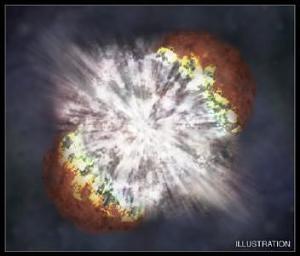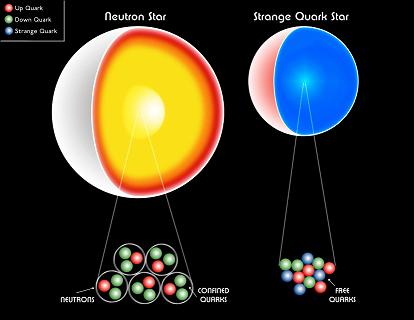Three supernovae that are 100 times brighter than the average brightness of neutron star-forming supernovae have led scientists to estimate that there may be an intermediate stage between neutron stars and black holes - quark stars

Neutron stars may not be the most dense exotic objects after all. Observations of particularly bright supernovae raise the hypothesis that these explosions produced even more exotic remnants. Neutron stars are formed after a star ends its life, and with a diameter of only 16 km and only 1.5 times that of the Sun, they may have become too large for the structure of the neutrons to hold them together.
What happens if the neutrons inside a neutron star also collapse? Quark stars (or "strange" stars) may be the result of such an event. They are much smaller and denser than neutron stars, which explains some of the recently observed protonormal supernovae.
Extremely luminous supernovae were recently observed by Canadian researchers. These huge explosions occur at the point where a massive star dies, leaving behind a neutron star or black hole. Neutron stars consist of material that has degenerated and left the neutrons in the nucleus of the atoms without the electrons surrounding them. Neutron stars are usually recognized as pulsars that spin rapidly and emit radio waves and X-rays. If the star was massive enough a black hole would form after the collapse, but is there an intermediate stage of stars that are too massive to become neutron stars but still too light to become black holes?

It seems that there are much smaller and much more massive stars, stars that are not composed of hadrons (such as neutrons) but of matter from which the hadrons are composed - the quarks. They are considered an intermediate stage at the point where the mass of the supernova remnant is too large for a neutron star, but too small to form a black hole. They consist of highly compressed quark material that turns into "strange" quarks, creating a state known as "strange matter". This is why these compact objects are also known as strange stars.
Quark stars may be hypothetical objects, but the evidence for their existence is beginning to accumulate. For example the supernovae SN2005gj,, SN2006gy and SN2005ap are 100 times brighter than the standard supernova explosion model. This phenomenon led a team of scientists from Canada to build a model of what might happen if a heavy neutron star becomes unstable, smashing the neutrons into a soup of strange matter. Although these supernovae may have created neutron stars, they became unstable and collapsed again, releasing energy from breaking the bonds of the hadrons, creating a "quark nova", thus turning the oversized neutron star into a quark star.
If quark stars are indeed the basis of the luminous supernovae, it is possible that they can be seen as large hadrons, held together not by the strong nuclear force but by gravity.

15 תגובות
I'm thirteen years old and I'm still curious to know what happens after all the stages. Is it just like a pupa? Does it make a circle? The information is very little!
Quarks make up all known matter.
There are anti-quarks, which make up anti-matter, but quarks are not anti-matter, they are the nucleus of matter.
From what I understand, the article implies that quark stars contain the same conditions as the very early universe (when matter was just starting to form from the energy that was there, about half a million years after the big bang?)
It doesn't make sense that there is a situation between a black hole and a neutron star as soon as the excess mass is less than 3.54 solar masses it is a neutron star and as soon as the mass of the body is greater than 3.54 solar masses it is a black hole there is nothing in between and also the remnants of a neutron star are matter and a quark is anti - Matter so it is impossible to assume that matter will turn into anti-matter without a situation where it turns into energy!
This is the weakest man in the world, the strongest man in the world, my uncle lifts 900kg
Shabbat Shalom, and in relation to the day after tomorrow, I am in the "galactic" turn today... so everything is allowed, for
Many world orders, of course.
Indeed, for the sake of good order, the link to the neutron, which is not a soup, but an abstract macro, is also necessary, and in order
Let's not preface anything, before we "catch on", we see in this article a reference to the phenomenon, the "quark" stars..
(By the way, they.. are not different, in the micro, the matters here, to the role that the "point" factor, and the gravity, which came to save the "world".. when they perceived.. Qantas... and Zamir..
And from here, I have to turn again for a moment, to the theory of "the great observation".. I will come, from there to today's article...
Slowly..who said you are not geniuses, here on this site...patience.
Well, don't attack me, what luck, that this is the Internet, and not an audience.. brainwashed.. and it is likely that we will all be sitting on chairs.. as for you..
And to the point, the short ones here and there, regarding terminology and language...when we, in different and strange ways, try
To decipher those wonderful phenomena in the universe..and within us..I have a Torah joke..straight from the barn..
..the cows were talking among themselves, moo and moo ..moo and moo..suddenly one of them started saying what..what..what
Her friends asked her.. what happened to you? Did you go crazy?? (in mo..mo..of course)..no!
..I'm learning..a new language..
No it's not, it's not related
And this is a hint that black matter is composed of the elementary matter (strings?) and not singularities.
א
If you went down yes! On the contrary, if you ascended, then Mark is a type of star
So if I got to the bottom of the matter, a certain claim is being made here that there is a star that is actually a kind of soup.
Amit
The strong force is activated between the hadrons by means of gluans, but when the quark soup is so compressed, the entire star forms one big hadron in such a situation, the gravity is activated with such great force that it prevents splitting within the soup into particles with any patterns.
What does this mean: "that are not held together by the strong nuclear force but by the force of gravity" The strong force does not also work with quarks? Or does the fact that neutrons are unstable mean that the strong force is not in the picture?
Thanks to those who answered 🙂
I am very intrigued to know what things are created as a result of a supernova explosion of such a body.. When it is known that a normal supernova explosion creates all the elements above iron..
(Could this be the source of organic compounds that we still do not know the source of?)
Thanks for the comments. fixed
to the editors
The reference is incorrect. Is the translation correct???????????????
The phrase hardon is mentioned throughout the article
The correct name is HADRON